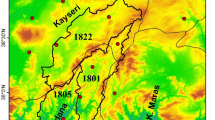Summary
Thin plate smoothing splines incorporating topographic dependence were used to interpolate daily global solar radiation in the Bavarian forest ecosystem monitoring network, with the degree of data smoothing determined by minimizing the generalized cross validation. A simple cross validation method was used to discuss the spatial distribution of mean relative errors at 18 forest climate stations. The results show that, from this network 14%–30% mean relative errors can be expected for most of these forest climate stations in summer, and 20%–30% mean relative errors can be found at a few of forest climate stations in winter. Time-averaging can reduce these interpolation errors. In this network a mean relative error of 10% can be expected for weekly and biweekly mean solar radiation at most of forest climate stations in summer. Large errors are related to low radiation amount under heavy cloud cover. Mean relative errors increase as daily global solar radiation decreases.
Similar content being viewed by others
Author information
Authors and Affiliations
Additional information
Received April 20, 1999 Revised January 20, 2000
Rights and permissions
About this article
Cite this article
Xia, Y., Winterhalter, M. & Fabian, P. Interpolation of Daily Global Solar Radiation with Thin Plate Smoothing Splines. Theor Appl Climatol 66, 109–115 (2000). https://doi.org/10.1007/s007040070036
Issue Date:
DOI: https://doi.org/10.1007/s007040070036




